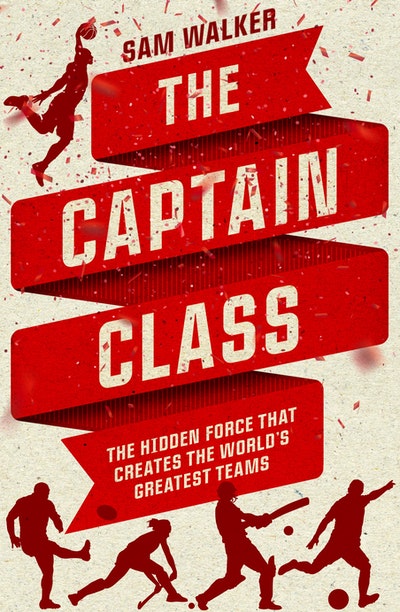- Published: 29 May 2017
- ISBN: 9780670078493
- Imprint: Viking
- Format: Trade Paperback
- Pages: 352
- RRP: $38.00
The Captain Class
The Hidden Force That Creates the World’s Greatest Teams
Extract
In 2004, I took a leave from my job to write a book about competing in America’s toughest fantasy-baseball expert competition. My strategy was to spend many days and nights with real major-league teams collecting inside information. The club I followed most closely was the Boston Red Sox.
The Red Sox franchise had a long and glorious history of failure and heartbreak dating back to 1918, the last time it had won a World Series. The moment I met them at spring training in February, I found little evidence that this season would be any different. Despite a sprinkling of stars, the roster was largely composed of misfits and castoffs—oddly shaped and sloppily bearded party animals with unconventional skills that other teams didn’t value. Behind the scenes I found them to be candid and funny, unpredictable and hopelessly undisciplined—a profile that would earn them the nickname The Idiots.
When Boston fell nine and a half games behind their rivals, the dynastic New York Yankees, I wasn’t the least bit surprised. I believed my first impression had been spot-on. The Red Sox were nothing like the dominant teams I had known. They weren’t championship contenders.
In early August, however, the Red Sox—like that youth baseball team of mine—seemed to fall under the influence of a spell. The Idiots started playing with confidence and ferocity, keeping cool under pressure and projecting a sense of unity and purpose I hadn’t seen in the spring. After clambering back up the standings and sneaking into the postseason, the Red Sox met the Yankees in the American League Championship Series and promptly lost the first three games. Before Game 4, the bookmakers put their odds of survival at 120 to 1. They would come within three outs of being eliminated.
Yet the Red Sox didn’t fold. They not only battled back to win Game 4 in extra innings, they defeated the Yankees three more times, capping the most dramatic postseason comeback in baseball history. Next came the World Series, where they swept the St. Louis Cardinals four games to none.
To Bostonians, who had endured one of the severest dry spells in sports history, this championship felt like deliverance. Three million people jammed the streets for a victory parade. There was even talk in the sports world that these Red Sox deserved a place among the greatest ballclubs of all time.
Here was a team that had been left for dead in July—and yet somehow the players had pulled together to form a brilliant, resilient whole. I wouldn’t call the Red Sox a dynasty—it would take them another three years to win a second title—but out of nowhere, they’d been gripped by a contagion that allowed them to play like every other magnificent team I’d observed. What I wanted to know, but couldn’t fathom, was why this happened. What provided the spark?
***
The following spring I started reporting an analysis piece for the Wall Street Journal that I hoped to call “The Secret Lives of Elite Teams.” My plan was simple: I’d come up with an objective formula for identifying the ten most accomplished dynasties in sports history, then trace their performances back to the moment they made the “turn” toward greatness to see if there were any similarities. Maybe these teams had all hired an inspiring coach, or drafted a standout player, or developed an innovative strategy.
The fact that this article never ran in the paper is not an indication of flagging interest. In fact, I developed the opposite problem. The deeper I dug, the more complex and engrossing the subject became. Just deciding how to define a “team” turned out to be a major undertaking requiring several weeks of spadework.
As I type this sentence, I’ve been working on the same line of inquiry for almost eleven years. I have reviewed and researched the accomplishments of more than twelve hundred teams across the world in thirty-seven major categories of sport since the 1880s. I have ripped through hundreds of books, articles, documentaries, scientific papers, and statistical analyses. I have tracked down interview subjects in Auckland, Barcelona, Boston, Chicago, Havana, London, Los Angeles, Madrid, Melbourne, Montreal, Moscow, New York, Paris, Perth, Rio de Janeiro, and dozens of sleepy hamlets in between.
When I started out, I never expected to reach one emphatic conclusion. I assumed the fingerprints of these elite units would have many of the same whorls and ridges yet no perfect matches. In the end, I was shocked to discover that the world’s most extraordinary sports teams didn’t have many propulsive traits in common, they had exactly one. And it was something I hadn’t anticipated.
The Captain Class is the culmination of a lifetime of watching sports, two decades of spending time in the orbit of world-class teams, and my own lengthy investigation into what drives the dynamics behind a surpassing collective effort. It’s not the story of one team’s triumph, although there are many triumphs recounted here. It’s not a biography of one transcendent star or coach, although many legendary figures will be discussed. Though it uses sports as its source material, it’s ultimately a book about a single idea—one that is simple, powerful, and can be applied to teams in many other fields, from business and politics to science and the arts.
It’s the notion that the most crucial ingredient in a team that achieves and sustains historic greatness is the character of the player who leads it.
The Captain Class Sam Walker
The former global sports editor of The Wall Street Journal profiles the greatest teams in history and identifies the counterintuitive leadership qualities of the unconventional men and women who drove them to succeed.
Buy now











